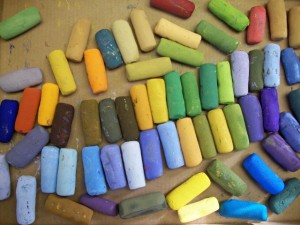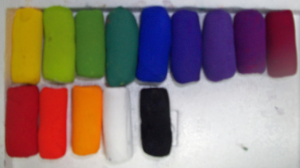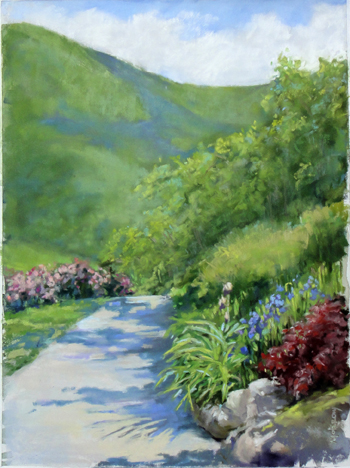An Introduction to Soft Pastels by Paul deMarrais
Paul deMarrais is an APS Member whose website is pauldemarrais.com
What is Soft Pastel?
Pastels are made by mixing dry artist pigments with water and binders and forming them into stick form, either by hand or by mechanical means. Pigments come from natural sources such as the earth pigments or they can be produced synthetically in the laboratory. These same dry pigments are used in all art mediums such as watercolor, oil and acrylic paints.
Because pastel is a dry medium, the color of pastel is the closest to pure color of any of the painting mediums. Pastel has a long and illustrious history dating back to the 1600’s and today is enjoying a surge in popularity among artists and collectors alike. Many excellent artists around the world are using soft pastel as their primary painting medium.
A Brief History of Pastel
Pastel has many great painters in its long history. Early masters like Rosalba Carriera{1675-1757} were portrait artists who painted charming portraits of their aristocratic patrons in a smooth heavily blended fashion which was the preferred style of her time. Later the great artist Jean Baptiste-Simeon Chardin {1699-1799} developed a painterly layering technique similar to the way pastel is used today.
Soft pastel once again became popular during the period of French Impressionism and in that era produced its greatest master Edgar Degas[1834-1917].
Degas was a fearless innovator who revolutionized pastel painting with his unusual techniques, magical color and great skill at composition and drawing. He brought pastel to wide acclaim in his lifetime and his work is priceless today.
The modern renaissance in pastel is relatively recent. In the 1970’s a pastel show was held in New York City that ushered in the birth of the Pastel Society of America, an organization entirely devoted to the pastel medium. The show was a great success and the society has grown and mushroomed into separate societies around the world showcasing the great talents of pastel painters today.
It is truly a wonderful era for pastel!
Types of Pastel
There are several types of pastels.
Most common are the familiar large pastel sticks which are referred to as ‘soft pastels’. These pastels have more pigment than binder which makes them softer. Smaller, often square sticks contain more binder than pigment and are referred to as ‘hard pastels’. Many artists use both types together in their painting technique.
Oil pastels are very different than these conventional dry pastels. They are made from beeswax, pigments and other chemicals and have a waxy crayon like character. They cannot be combined with soft or hard pastels as they would create a slick surface that would prohibit proper adhesion. Oil pastel technique is also quite different than techniques used in soft and hard pastel.
Surfaces for Soft Pastel
Pastel can be used on many surfaces, as long there is sufficient grab or ‘tooth’ to hold the pastel layers. What surface an artist uses is a factor in determining the final look of a pastel painting.
Surfaces can be loosely categorized into two categories. There are fibrous papers like those traditionally used in watercolor, printmaking and drawing and there are sanded papers where an abrasive has been applied to the surface to help grip the pastel.
Pastel can also be used on canvas as well as long as it is not too slick. More layers of soft pastel can be built up on a sanded surface.
Sanded surfaces are probably the most popular surfaces in use in today’s pastel painting. Marble dust, aluminum oxide and pumice are some of the abrasives used to create sanded surfaces. The type of surface used becomes a matter of personal preference for each pastel artist.
What is always important is that the surface is an archival, permanent surface that will not discolor or decay over time. Properly framed pastels are as permanent as oil or any other medium and excellent examples from the 1600’s are as fresh as the day they were painted.
Pastel Supplies….What do I need?
Beginning pastel artists are often overwhelmed by the gear involved in painting but it need not be intimidating! Artists quickly learn to streamline their gear so it is convenient and practical and causes the least amount of frustration during the painting process.
To start out you will need a set of a minimum of 25-50 colors. Many of the manufactured brands have these introductory sets available. From there , you can build your palette by adding colors that best suit the needs of the subject matter you choose to paint. Perhaps later on, you could choose to purchase a larger set if you wish to explore all the potential of pastel color.
Premium sanded papers can be expensive but you can save a great deal by making your own sanded surface. You’ll still have a wonderful surface to accept the soft pastel. You can also use a number of toned pastel papers to start out if you wish.
Many artists use easels which come in many styles and designs while some artists prefer to work on a flat surface. It is important to use the best materials you can afford so that your first experiences are the best they can be!
Framing and Storage
Every medium has its challenges and for pastel framing can be troublesome and expensive.
Fortunately the explosion of interest in pastel has lead to great new methods of framing and more galleries and frame shops that have experience in framing pastels.
In lieu of framing, pastels can be stored easily by stacking them carefully. Care must be taken to tape them in a way that there is no side to side movement of the pastels which will cause smearing. Having a strong surface is helpful in solving storing pastels successfully.
Of course, the best and only way to ensure total safety of a pastel painting is to frame it behind glass, preferably with a spacer or a mat to separate the glass from the artwork. Framed correctly a pastel will last a lifetime and more.


